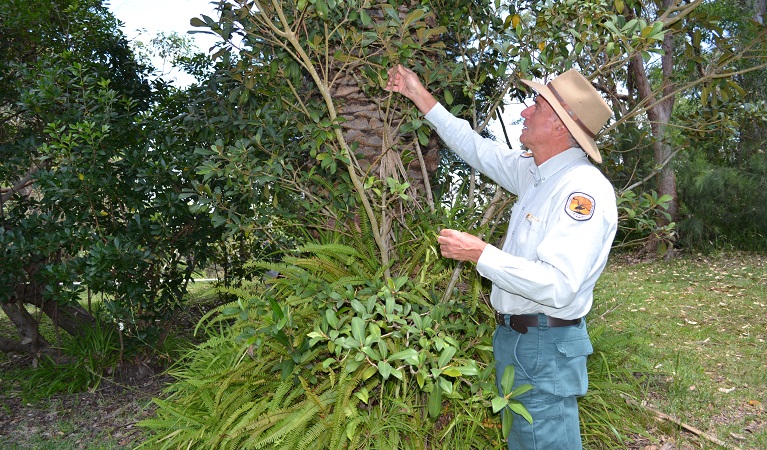School excursion
WildThings at Bradleys Head
Sydney Harbour National Park
Open, check current alerts
Overview
Book your WildThings school excursion for Stage 1 (Years 1-2) students in Sydney Harbour National Park. Together we'll explore the living world and identify the features that help native plants and animals thrive here.
Read more about WildThings at Bradleys Head
Using our senses, skills of observation and language, we'll explore and describe the diverse adaptations of plants and animals. Our adventure will include a hands-on investigation into bug and animal habitats, along with nature play.
This is a fun and immersive harbourside excursion for young, enquiring minds.
For program outline, safety and practical information about this excursion, see info for teachers
| Stage | Stage 1 (Years 1-2) |
|---|---|
| Learning area | Science and Technology |
| Student outcomes |
ST1-1WS-S. Observes, questions and collects data to communicate and compare ideas and comparing what they and others know ST1-4LW-S. Describes observable features of living things and their environments STe-6ES-S. Identifies how daily and seasonal changes in the environment affect humans and other living things |
| Objectives |
Students will:
|
Excursion details
- When
Weekdays during the school term, 10am to 2pm, including meal breaks
- Availability
- Guided. Available on request.
- Duration
- 4hrs
- Grading
- Easy. Guided tour and activities along an unsealed walking path, including a board walk, grassed area and stairs.
- Price
-
$17 per student. Minimum of 20 students. GST included.
- Accessibility
- Medium
- Meeting point
- Athol Hall carpark, where Bradleys Head Road meets Athol Wharf Road.
- Equipment
provided - Yes
- Booking
- If you would like to organise a NSW National Parks school excursion please get in touch with local staff or use the 'Enquire now' link for the online form
Local alerts
For the latest updates on fires, closures and other alerts in this area, see https://www.nationalparks.nsw.gov.au/education/stage-1-science-technology-wildthings-bradleys-head/local-alerts
Operated by
- School excursion inquiries - Sydney Harbour
- 02 9668 2006
- 02 9337 7012
- sydney.discovery@environment.nsw.gov.au
Park info
- in Sydney Harbour National Park in the Sydney and surrounds region
Sydney Harbour National Park is open sunrise to sunset but may have to close at times due to poor weather or fire danger.
-
Park entry fees:
Bradleys Head: $8 per vehicle per day. North Head: $5 per vehicle per day. Tap and pay card or phone payments accepted at pay machines. Coin payment available at Fairfax carpark machines only. Chowder Bay: Monday-Friday: $3 per hour, to a maximum of $16 per day. Saturday, Sunday and Public Holidays: $4 per hour, to a maximum of $20 per day. If you hold an NPWS All Parks or Multi Parks Pass, you can park free for up to four hours per day - additional time can be purchased. Car parks operated by Sydney Harbour Federation Trust or Mosman Council are not covered by your pass. Please check signs carefully. Park’nPay: You can also pay for your visit to any area via the Park’nPay app.
Other fees:
Landing fees or tour fees apply to visit Sydney Harbour islands. All public visitors to Shark, Clark or Rodd Island, need to pay a $7 per person landing fee. To arrange, please contact 1300 072 757 (13000 PARKS). Annual NSW Parks Passes do not cover landing fees.
Buy annual pass.
Info for teachers
All the practical information you need to know about WildThings at Bradleys Head.
Program outline
- Welcome, acknowledgement of Country and safety talk
- Introduction to the site and overview of what the excursion will entail
- Short walk to Bradleys Head Amphitheatre, morning tea and toilet break
- Identify the living environments of various animals and plants, and examine the specific adaptations that support their survival
- Investigate the structural features of native plants and the animals they host
- Lunch at Bradleys Head Amphitheatre
- Explore the local environment using scientific tools for enquiry (for example, magnifying glasses)
- Use bug charts to identify and discuss different features of the minibeasts that live here
- Take the return walk to Athol Hall. Discuss the physical features of the harbour, including the difference between a bay and a harbour.
- Farewell and depart on bus
Getting there and parking
Get driving directions
Bradleys Head is located between Athol and Taylors Bay. Travelling by bus, drive along Military Road, Mosman and then continue to Bradleys Head Road to the parking area near Athol Hall.
Road quality
- Sealed roads
Vehicle access
- 2WD vehicles
Weather restrictions
- All weather
Parking
Parking is available at Bradleys Head and at nearby Athol Hall. There is also parking at the Rifle Wall.
What to bring
It’s a good idea to wear long pants, closed comfortable shoes and bring a hat and sunscreen. Be ready for all weather conditions with a jumper and raincoat. And remember to bring food, water, first aid kit and any necessary medications
Maps and downloads
Risk assessment
Our rangers and guides have the technical skill and experience to assess the risks and the benefits of a variety of activities delivered as part of our learning programs.
We believe in including opportunities that allow students to learn and experience for themselves through exploration in the natural environment.
Please make your own risk assessment based on the information provided. Detailed potential risks and controls are provided for the site to assist teachers in risk management planning. Teachers and carers should be aware of, and consider the needs, abilities and medical conditions of students when visiting this site. The supervision of students remains the responsibility of the teacher. The school must ensure an adequate number of adult supervisors are present.
Accessibility
Disability access level - medium
Alternative access is possible to some areas.

